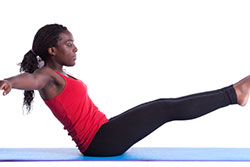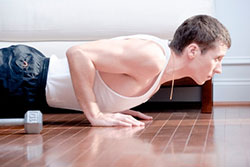Back to the February Issue
How to Get More From Your Core
By Stephen Tamm
The part of your body known as “the core” got that name for a reason: it holds you together. The core muscles work together with the skeletal system to keep your entire body balanced and properly aligned.
You can think of your core like the foundation on which you build strength throughout the rest of your body. Without a strong and conditioned core, there won’t be much to build on. Some people wonder, however, what difference this makes if they aren’t interested in having “six-pack abs.” In truth, core strength is important for a lot more than your appearance.
Emma demonstrates variations of planks and sit-ups. (MP4, 03:09)
WHAT
So maybe you’re asking, “Which muscles actually get to be called ‘core muscles,’ and what do they do individually?” Here’s the answer: your core consists of the muscles surrounding your mid-section that allow you to stand upright and resist force (gravity, wind, backpacks, etc.).This area is also known as the lumbo-pelvic-hip complex. Lumbo refers to the lumbar region of your back, pelvic refers to the bone formation, and hip indicates the region where the legs attach to the pelvis. These parts of your body, working in conjunction, are considered to be your core.
According to Rob Maggio, a strength and conditioning coach at St. Clair College in Windsor, Ontario, the core is composed of multiple layers of muscles.
“The core muscles are the deep muscles of the body,” Maggio explains. “You have a superficial layer and you have an inner layer. The transverse abdominal muscle and the internal obliques are in that inner layer. They are located in the abdomen region, and they wrap all the way around to the lower back. This gives you a full-body protection belt. These are the primary core muscles.”
In order to simply stand, you’ve got to be able to stabilize your upper body against 360? of force. Because there is no bone support between the sternum and the pelvic floor, the muscles of your low back keep you from doubling over like you would if Chuck Norris knocked the wind out of you.
On the opposite side of your body, the abdominal muscles help take the load off of your spine, which keeps you from bending over backwards. Other muscles in the core system wrap around the sides of the body, surrounding the hips and providing stabilization against side-to-side movement.
Stephen demonstrates four exercises for the core. (MP4, 02:32)
WHY
Weak core muscles, developed typically by lack of use, contribute to problems with posture, skeletal deformities, imbalances in strength, back pain, and may even be the cause of most chiropractor appointments.In fact, Dr. Chris Dismukes, a chiropractor and owner of Infinity Chiropractic Clinic in La Porte, Texas, points out that by developing a strong core early in life, you can greatly reduce the risk of developing the hip, back, and neck problems that are so common among older people. A strong core can help prevent deterioration and even injury.
In addition to simply keeping you upright, your core muscles are recruited for things like walking, lifting, and oh, looking good poolside, too.
Wayne Campbell, a sports therapist at St. Clair College, points out that people can develop weaknesses in the core because they don’t use certain muscles when sitting for extended periods of time during work or at school.
“The core muscles are the center of your body. It’s like a fulcrum,” Campbell says. “It’s your stability; it’s your whole power system. There are many muscles involved in the core, and depending on the activity you’re doing, they contribute to the force you have to generate the speed that you need. Otherwise, it becomes your anchor [and can] weigh you down.”
In order to keep your body working properly and avoid pain, even if it’s just the stiffness many people experience when getting out of bed, you’ve got to devote a little strength and stretching work to your core musculature.
Airyn shows a 7 step ab workout. (MP4, 04:56)
HOW
Every core workout should include movement in the front, back, and side-to-side planes, as well as rotational exercises. Overworking one plane of motion (like doing nothing but crunches) is actually counterproductive.Dr. Dismukes explains that too much ab work, without sufficient back work, or vice versa, will lead to postural problems and unnecessary fatigue.
The first thing you want to consider when coming up with your own core workout is any imbalance or weak area that needs to be addressed. A weak back may lead to pain if it’s not used on a regular basis. Weak hips will affect balance, posture, and range of motion. Recognizing what needs the most work will give you a good starting point. For help assessing where you may need to build strength, speak with a trainer or coach at your school’s gym or fitness center. Most campuses have these services available for no cost.

Another thing to consider is your own fitness level and regular activities. A person who has to lift and move things often should try to strengthen the core with weight training. A person who doesn’t lift anything regularly might consider yoga or Pilates to strengthen the core using body-weight resistance and isometric stabilization.
Remember that your core is holding you together. Neglecting your core muscles puts you at risk for injury, arthritis, postural imbalances, and general physical discomfort. Try to dedicate 15 minutes of your regular workout or activity time to strengthening your core. For extra motivation and support, check out the fitness classes and exercise groups at your campus recreation center. You’ll be glad you did!
Take Action!
- A strong core contributes to overall health. Think of it as the foundation on which the rest of your body is built.
- Recognize core imbalances and work to overcome them.
- Train your core for movement in every direction.
- Core strengthening exercises can be done with and without equipment. Consult a trainer or athletic coach for suggestions.
- Be creative with your exercises to make your workout fun.
- Choose exercises that match your lifestyle and ability.
STEPHEN TAMM is a graduate of West Texas A&M University, a certified personal trainer, and is training to be a nutritionist.
There are many useful exercises you can try. You’ll want to address the various planes of motion.
Good mornings
Eliza Demonstrates Good Mornings. (MP4, 00:57)
Start with a light bar resting on your shoulders like you would for a squat. Keeping your chin up, lean forward until the bar is almost at waist level and return. Make sure you’re not straining and keep the weight manageable.
Supported or Hanging leg lifts
Eliza Demonstrates Supported or Hanging Leg Lifts. (MP4, 00:49)
Hanging leg lifts are a challenging exercise, so you may need to build strength before doing them. Start by supporting yourself on a chair or with arm straps and focus on just lifting your legs. Think about keeping your legs in front of your body the entire time and moving with complete control.
Cable hip abductors
Eliza Demonstrates Cable Hip Abductors. (MP4, 00:37)
Begin with the pulley set low, one ankle attached, and stand perpendicular to the pulleys. Allow the attached leg to cross in front of the other. Squatting just a bit on the supporting leg, extend the attached leg out and away from your body. Repeat on the other side.
Oblique ball crunches
Nick demonstrates oblique ball crunches. (MP4, 00:43)
Lean sideways over a Swiss ball so that you’re supported on your hip. Relax and cross your hands behind your head. Keeping your feet firmly planted, raise your shoulders straight up until your body is straight, at approximately a 45? angle from the floor.
Cable rotations
Eliza Demonstrates Cable Rotations. (MP4, 00:40)
There are a few ways to do these, and they’re all great for core conditioning. Begin standing perpendicular to a set of pulleys. Reach across your body to grip the cable attachment and rotate away from its base. You can start low and reach high, start at chest level and rotate flat, or start high and bring the cable down (like swinging an ax).
Medicine ball side pass
Eliza Demonstrates the medicine ball side pass. (MP4, 00:51)
Stand back-to-back with a partner, and hold a medicine ball close to your body. Turn to one side, pass the ball to your partner, and then grab it from him or her on the other side. Do these for a while in one direction and then switch to the other.
Isometric planks
Nick demonstrates isometric planks. (MP4, 01:22)
In a prone plank, support yourself in sort of a push-up position, either on your hands or forearms. In a side plank, support yourself on the side of one foot and either one hand or forearm. In a supine plank, face up with your feet and knees together, head off the ground, and only your shoulder blades and feet touching the ground.

